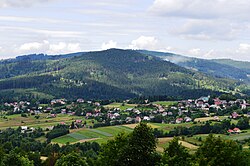|
Istebna
Istebna [iˈstɛbna] ⓘ is a large village and the seat of Gmina Istebna, Cieszyn County in the Silesian Voivodeship, southern Poland. The village is situated in the Silesian Beskids mountain range, near the borders with the Czech Republic and Slovakia, in the historical region of Cieszyn Silesia. The Olza River flows through the village. EtymologyThe name is cultural in origin, derived from the word (j)istba, meaning a room in a (especially rural) house (see also izba). It is conjectured that the name was conveyed by settlers from Istebné who supposedly established the village. Historically, it was also known as Gistebna (1621, 1629) or Istebne (1724; the name in plural form, meaning rooms).[1] HistoryThe village was first mentioned in a 1592 document, which retrospectively mentioned a village called Jistebne which was around As early as 1583.[2][1] It belonged then to the Duchy of Teschen, a fee of the Kingdom of Bohemia and a part of the Habsburg monarchy. After the 1848 Revolutions in the Austrian Empire, a modern municipal division was introduced in the re-established Austrian Silesia. The village as a municipality was subscribed to the political district of Cieszyn and the legal district of Jablunkov. According to censuses conducted in 1880, 1890, 1900 and 1910, the population of the municipality grew from 2,112 in 1880 to 2,245 in 1910, with the majority being native Polish-speakers (between 98.2% and 99.5%), accompanied by German-speaking (at most 33 or 1.5% in 1890) and Czech-speaking people (at most 15 or 0.7% in 1880). In terms of religion, in 1910, the majority were Roman Catholics (93.9%), followed by Protestants (5.9%) and Jews (6 people).[3] The village was also traditionally inhabited by Silesian Gorals, speaking Jablunkov dialect. After World War I, the fall of Austria-Hungary, the Polish–Czechoslovak War and the division of Cieszyn Silesia in 1920, it became a part of Poland and was transferred to Cieszyn County. It was then annexed by Nazi Germany at the beginning of World War II. After the war, it was restored to Poland.
LandmarksThere is a Catholic church in the village known as the Good Shepherd Church, built in 1794 from the previous wooden one. Notable people
Twin townsGallery
Footnotes
References
External links
Wikimedia Commons has media related to Istebna. |
||||||||||||||||||||||||||||||||||||||||||||||||
Portal di Ensiklopedia Dunia

















